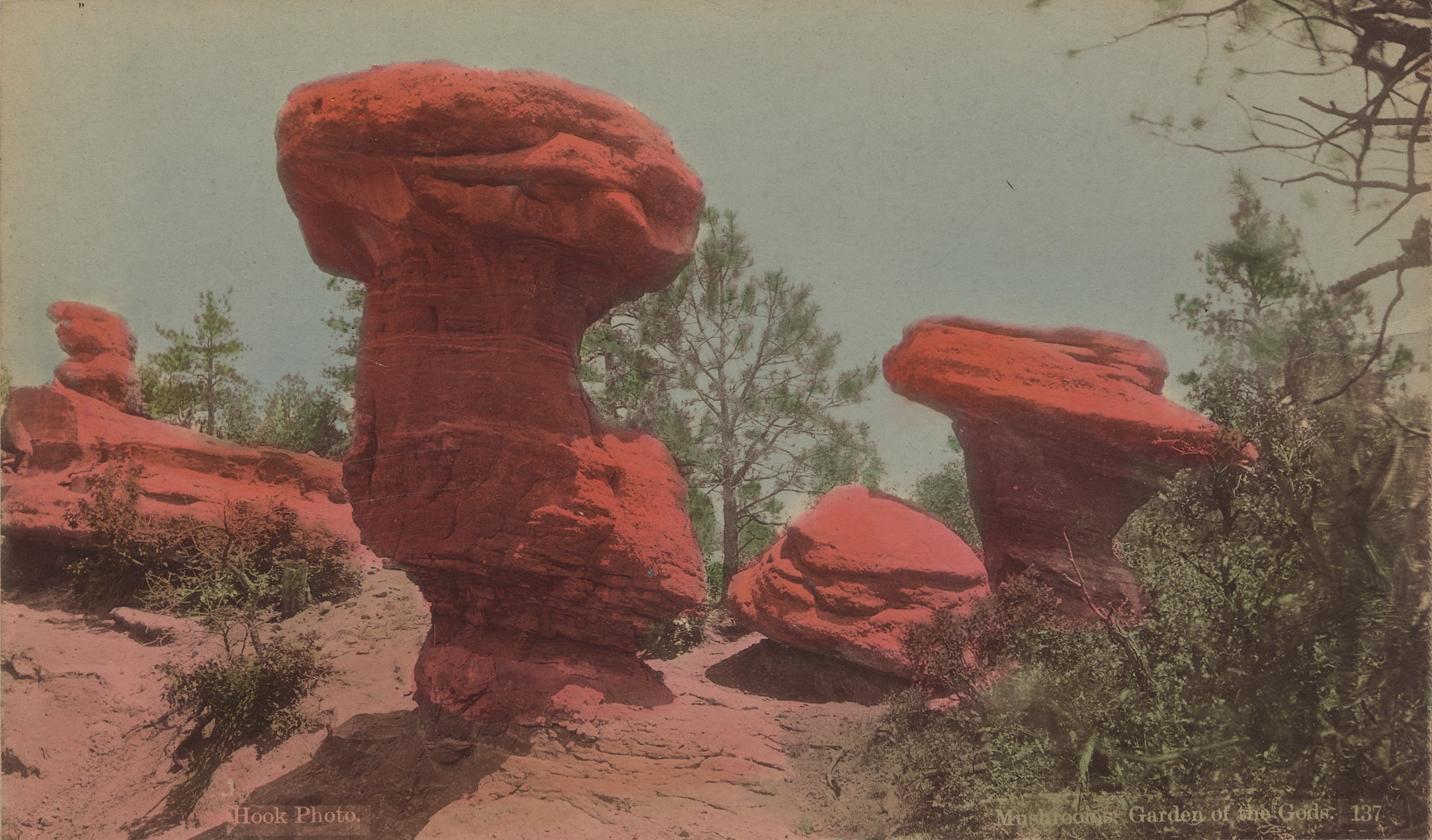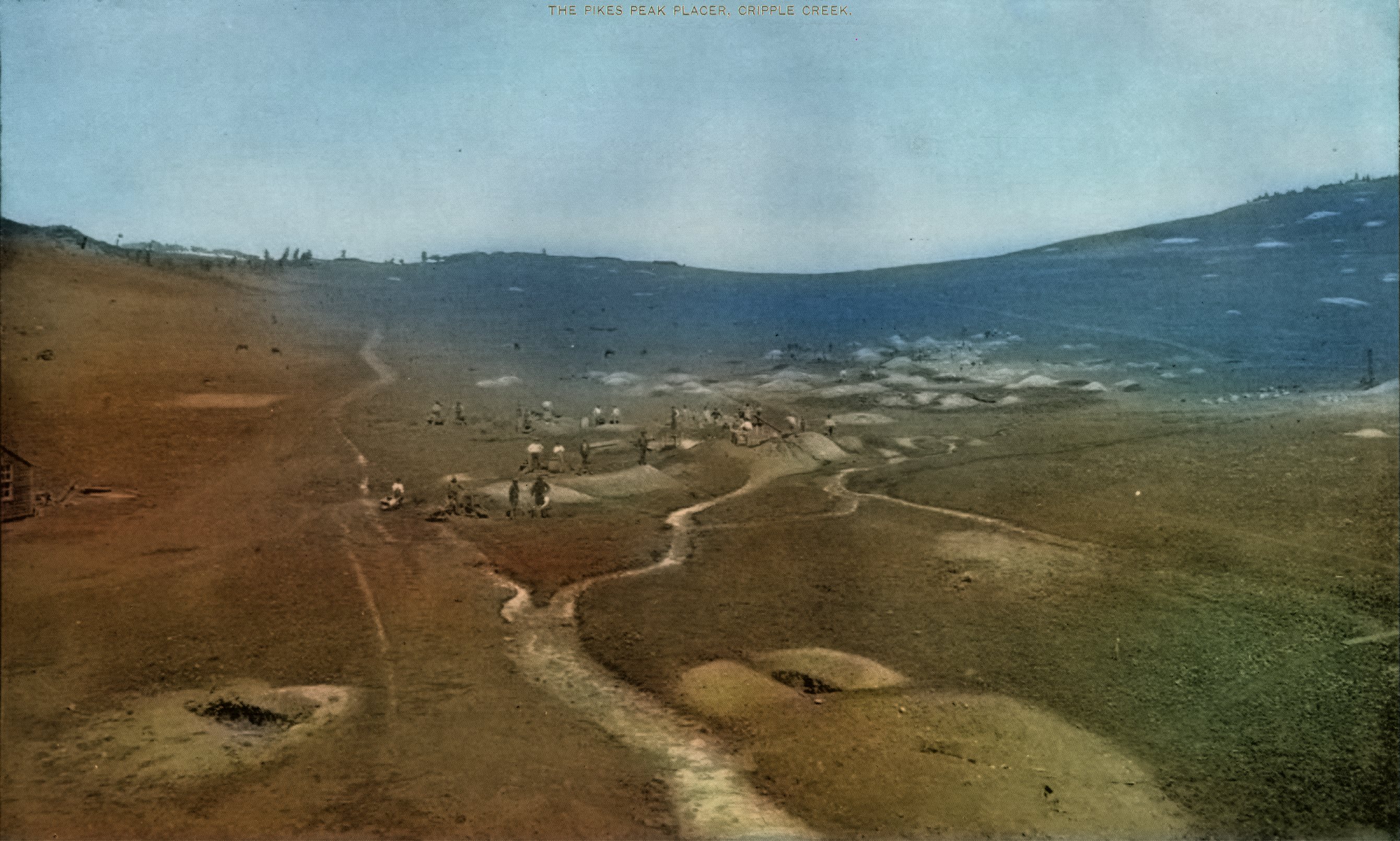-> Found at the Colorado Historic Newspaper site. Or direct to the text.
Sunday Morning, December 31, 1899.
(page 18 or numbered 14)
Source had no images, so I used a couple from my collection.
Eons of time back, before life of any kind existed, the earth was a whirling ball of incandescent matter, surrounded by water, which, bubbled, sputtered and leaped with the heat. The center of the globe was fire—intense fire.
As the ball went spinning through space, the heat forced curious changes. First great dykes of matter were thrown upward toward the surface, and as the dykes left the center of disturbance and the source of the heat, it cooled, and from a molten mass was transformed into rock, and the granite foundation of the world of to-day was laid, forged in the bosom of the earth.
Some of the dykes extended through the water, and reached upwards thousands of feet, but with no regularity.
The dykes were broken, twisted heterogeneous masses of rock traversing the face of the water, in places a few hundreds of feet, in others hundreds and thousands of miles long. From the center of the water covered globe the granite walls radiated like the spokes of a giant wheel, the spaces between them in some places being a mile or two in width.
Time passed on, and then upward there came another flow of rock, between the spaces in the great granite walls. As the new flow reached the top of the dykes, it flowed outward and over, in great tongues. In some places the water was extremely hot, yet, though since the time of the vomiting up of the granite, the water had been gradually cooling. The rock that hardened under the water, while yet hot, became what is known as porphyry. In another case, where the water was cool, or had receded, the second rise of rock in liquid mass, cooled more rapidly, and is known as phonolite. It cooled so fast that it is brittle, and has a bell like ring when struck with a piece of iron or steel.
Then came other flows and wretchings of the rocky mass of the future world. Dykes miles in length and miles in depth were split. Future mountains were torn asunder, settled toward or from each other, and then came a mass that filled in between the spaces of granite, porphyry and phonolite, known as basaltic lava. Some time after working its way through great mountains, it is found in a soft state and at others it is quite hard, and then the net work of the world having been formed, there came a period of lesser activity. The waters receded, only to rise again in great clouds of steam. The earth was obscured. The sun striking it on one side, the light was carried around to the other. There was no night. The darkest hour was a semi-twilight. The sun never shone brightly. It was hazy. Torrents of water, burning and scalding fell from the skies only to strike the scorching surface of the earth, to be evaporated, and mounted heavenward again in jets of steam to form great banks of clouds, which arose into the upper regions, and, away from the heat, to condense and fall back to the earth in the form of water, which was again heated as it came into the hotter air. This condition changed. There was less haze, the water was receding and then the fires beneath the world's structure began to force water upward.
The water sought passage ways between the granite and porphyry walls. With the water came precious metals in solution, gold and silver, over which men were to fight, nations to war, on which the happiness and misery of future millions was to depend, came up from the center of the earth.
Wherever there were walls of basaltic lava, the mineral was attracted. The spaces between the great walls became veins. The water carried silicia and other substances. Where the veins were wide and dipped from the vertical, the water run slower in its course, and the precious metal was precipitated to the lower or foot wall. Where the veins stood more vertical and were straighter, the values adhered to the hanging wall. Where they were narrow, very little value was left. Other matter was deposited with the precious metal, and then the flow of water ceased. By and by, during the course of ages, there was another flow, this time of salt water, and more values came up from the center of the earth, and were deposited in the veins. Sometimes the veins were miles in length, but the values were only deposited in certain places, and these places became the future ore chutes.
Then came the third flow of fresh water, again like the first. In some places the veins had been filled, and other veins were barren, and in the third flow it was not infrequent that the water, in its action, would take the precious metal from one vein, carry it to a considerable distance, and deposit it in another that was formerly barren. This is what is known as robbing a vein.
Then the flow or water ceased and the winds began to blow. A little sand swept around the corner of this rock or that, and soon wore it into a form that resembled a mushroom or a toad stool, and it finally disappeared, and these fine particles falling on the rock, and the dust from meteoric showers from space, and other causes, carpeted the rocky surface with earth. It was still warm, and vegetation came, that attained a rank growth in the ultra tropical climate. Forests arose quickly, and died away in a short time, and the remains added to the velvety earth, and new vegetation came, one succeeding the other very rapidly for millions and millions of years, until after a while, the lapse of which is beyond the calculation of man, the granite floor of the world was covered, valleys were formed, the lakes and oceans were plainly marked, life appeared, the iron was formed, the lime began its descent to the center of the earth, coal beds made by the masses of decayed vegetation, were covered and were undergoing changes from wood, and bog and pete to the black diamonds, and the earth lurched several times in its orbit, the climate changed, a satellite came, and a bitter condition on the high peaks of rocks, now mountains, ensued. Frost and snow settled. The intense cold contracted the rocks. In expanding again they cracked, broke, and rolled down hill, covering over the original surface, filling up the valleys, forming a new coating to the earth into the mountain chains, long after the same thing had occurred in the lower countries. This condition transpired through thousands and thousands of centuries, and the broken mass of rock was the wash.
Then came the pine, the scrub oak and the aspen tree. Pine needles fell and rotted, and a new surface came again, grass, rank, grew, died and rotted away, and the veins that protruded through the rocky eminences were hidden from view, and were buried deeper and deeper with each succeeding year, and the Cripple Creek of to-day, with her great treasure vaults of wealth, was hidden from the world.
Then came man, savage, and after centuries came civilized man, who drove back the barbarian, and settled in these hills.
He picked up pieces of rock that showed gold and proceeded to hunt for its source.
The original crust of the earth being hidden, he dug a hole until he reached the solid formation. Then he proceeded to make a trench, like a long ditch until he encountered a vein where it protruded through the earth, and then he changed the course of his ditch to follow the course of the vein, first this way and then the other, until he located the ore chute that came up through the rock in the vein, and on that he sank his shaft and removed the rich mineral bearing rock, which he sent to the mills and the smelters.
And so the people of to-day are robbing nature of the work of millions of years of silent toll, and in nine years there has been removed from the ground ores that required the lapse of quintillion of ages to deposit.
That is the way the ore was laid in the vein, and such, geologists tell us, was the early history of Cripple Creek. The story is not told in the language the geologist would use, with a verbiage of scientific words to confuse and bewilder the average man, but so that all may understand just how the action of fire, water and gas, heat and cold, combined to make in nature's laboratory, a district six miles square, that is destined to be the greatest gold mining region the world has ever known or the sun will ever shine upon.

